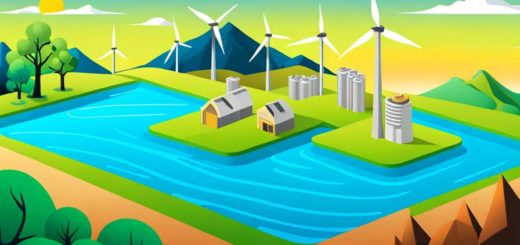How Australia Is Leading the World in Renewable Energy Transition

As the world continues to combat climate change, Australia has been making significant strides in transitioning to renewable energy. The importance of renewable energy in Australia cannot be overstated, as it plays a crucial role in reducing the nation’s carbon footprint and supporting sustainable agriculture in Australia. This article provides an overview of Australia’s renewable energy targets, and explains how the country is harnessing various renewable energy sources to achieve these goals.
One of the key driving forces behind Australia’s renewable energy transition is the nation’s ambitious renewable energy targets. The Australian government aims to achieve 50% renewable energy by 2030, and ultimately reach net-zero emissions by 2050. These targets are crucial for Australia to meet its international climate commitments and reduce its carbon footprint in Australia.
The Role of Solar Energy in Australia’s Renewable Energy Transition
Solar energy has been playing a significant role in Australia’s renewable energy transition. With abundant sunlight and vast open spaces, the country is ideally positioned to harness the power of the sun to generate clean, sustainable electricity. This section delves into the state of solar energy in Australia, and highlights the implementation and impacts of solar energy across the nation.
Over the past decade, solar power capacity in Australia has grown exponentially. According to the Clean Energy Australia Report for 2023, solar energy now accounts for more than 25.8% of the country’s total electricity generation. This rapid growth can be attributed to the falling costs of solar panels, government incentives, and increasing awareness of the benefits of solar energy among the Australian public.
Implementation of solar energy projects across Australia has led to numerous positive impacts, including reduced greenhouse gas emissions, job creation, and increased availability of eco-friendly products in Australia. However, there are also challenges associated with the rapid expansion of solar power, such as grid instability and the need for improved energy storage solutions.
Wind Energy in Australia’s Renewable Energy Transition
Wind energy is another crucial component of Australia’s renewable energy transition. The country’s vast, windy coastlines offer immense potential for harnessing wind power, making it an attractive alternative to fossil fuels. In this section, we discuss the state of wind energy in Australia and the implementation and impacts of wind energy projects throughout the country.
Wind energy has experienced rapid growth in Australia, with the capacity more than doubling over the past decade. As stated by the Australian Renewable Energy Agency, wind power now contributes to over 7.1% of the nation’s total electricity demand. This growth has been fueled by technological advancements, supportive government policies, and increasing demand for clean energy.
The implementation of wind energy projects has led to several benefits, such as reduced dependence on fossil fuels, decreased greenhouse gas emissions, and job creation in the renewable energy sector. However, there are also challenges associated with wind energy, including concerns over wildlife impacts, land use conflicts, and intermittency issues.
Hydro Energy in Australia’s Renewable Energy Transition
Hydro energy is another key player in Australia’s renewable energy transition. Harnessing the power of water through hydroelectric dams and pumped storage systems, hydro energy can provide a reliable and sustainable source of electricity. In this section, we explore the state of hydro energy in Australia and its implementation and impacts on the nation’s renewable energy transition.
Hydro energy has long been a staple of Australia’s renewable energy mix, with a history dating back to the early 20th century. Today, hydro energy accounts for approximately 7% of the country’s total electricity generation. While the growth of hydro energy in Australia has been relatively modest compared to solar and wind power, it remains a crucial part of the nation’s renewable energy strategy due to its ability to provide baseload power and help stabilize the grid.
The implementation of hydro energy projects has had several positive impacts on Australia’s renewable energy transition, including a reduction in greenhouse gas emissions, increased grid stability, and the creation of jobs in the renewable energy sector. However, challenges associated with hydro energy include high upfront costs, environmental concerns, and competing demands for water resources.
Australia’s Renewable Energy Storage and Future Prospects
As Australia continues to expand its renewable energy capacity, energy storage solutions become increasingly important. Effective storage systems are essential for overcoming the intermittency issues associated with solar and wind power and ensuring a reliable supply of electricity. In this section, we discuss the state of renewable energy storage in Australia and its implementation and impacts on the country’s renewable energy transition.
There are several types of renewable energy storage technologies being explored and implemented in Australia, such as battery storage, pumped hydro storage, and thermal energy storage. Battery storage, in particular, has experienced rapid growth in recent years, thanks to advancements in lithium-ion battery technology and decreasing costs. Large-scale battery projects, such as South Australia’s Hornsdale Power Reserve and Victoria’s Ballarat Energy Storage System, have demonstrated the potential of battery storage in stabilizing the grid and supporting the integration of renewable energy.
The implementation of energy storage solutions has had a range of positive impacts on Australia’s renewable energy transition, including improved grid stability, reduced reliance on fossil fuel-based peaking power plants, and increased flexibility in managing electricity supply and demand. However, there are also challenges to overcome, such as high costs and the need for further technological advancements to increase storage capacity and efficiency.
Case Studies on Australia’s Renewable Energy Transition
South Australia’s Renewable Energy Success Story
South Australia has emerged as a global leader in renewable energy, with ambitious targets and a diverse mix of solar, wind, and battery storage projects. In 2020, the state achieved a remarkable milestone, generating more than 60% of its electricity from renewable sources. The success of South Australia’s renewable energy transition can be attributed to strong government support, favorable natural resources, and a forward-thinking approach to energy policy.
Victoria’s Renewable Energy Transition and Targets
Victoria has also made significant progress in its renewable energy transition, driven by a commitment to reach 50% renewable energy by 2030 and net-zero emissions by 2050. The state has invested heavily in solar and wind power projects, as well as battery storage systems, to support its transition to a clean energy future. The success of Victoria’s renewable energy transition demonstrates the potential of coordinated government action and private sector investment in driving the adoption of renewable energy technologies.
The Northern Territory’s Renewable Energy Goals and Challenges
The Northern Territory faces unique challenges in its renewable energy transition, due to its remote location, vast distances, and small population. Despite these challenges, the territory has set ambitious renewable energy targets, aiming to reach 50% renewable energy by 2030. To achieve these goals, the Northern Territory is focusing on the development of solar energy projects, coupled with energy storage solutions, to overcome the limitations of its existing energy infrastructure.
Conclusion
Australia’s success in the renewable energy transition is evident in its rapid adoption of solar and wind power, as well as its continued investment in hydro energy and energy storage solutions. As mentioned earlier, the nation’s ambitious renewable energy targets, coupled with strong government support and private sector investment, have driven significant progress in this transition. However, it is important to acknowledge the challenges that still lie ahead, such as grid stability, high costs, and the need for further technological advancements.
Looking to the future, Australia’s renewable energy progress holds immense potential for continued growth and innovation. The development of new technologies, along with improvements in energy storage solutions, will play a key role in addressing the challenges faced by the nation’s renewable energy sector. Additionally, the ongoing global shift towards cleaner, more sustainable energy sources is likely to drive further investment and international collaboration in the field of renewable energy.
The importance of continued efforts in the renewable energy transition in Australia cannot be overstated. The nation’s success in reducing its carbon footprint, supporting sustainable agriculture, and promoting eco-friendly products will not only benefit the environment but also help to create a more sustainable and prosperous future for all Australians.
In conclusion, Australia’s renewable energy transition serves as an inspiration for other countries looking to embrace clean, sustainable energy sources. By learning from the successes and challenges faced by Australia, nations around the world can work together to combat climate change and create a greener future for all.
Be sure to explore case studies and real-world examples of renewable energy projects in Australia. For instance, South Australia’s Hornsdale Power Reserve, Victoria’s Ballarat Energy Storage System, and the Northern Territory’s solar energy initiatives can provide valuable insights into the practical implementation and impacts of renewable energy technologies.
Together, we can learn from Australia’s renewable energy transition and work towards a cleaner, more sustainable future for our planet.



